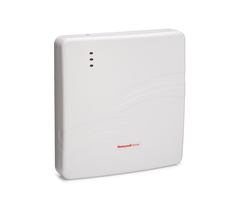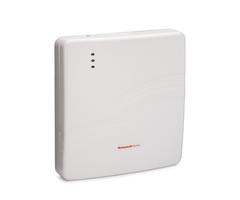How Do I Install the Resideo LTE-IA or LTE-IV On My VISTA-15P or VISTA-20P?
You can install the Resideo LTE-IA or LTE-IV on your VISTA-15P or VISTA-20P by testing signals, mounting the communicator, powering down the VISTA-15P or 20P, connecting the communicator, mounting to the panel, powering the panel on, and activating for monitoring service.

Other names for the Resideo LTE-IA and Resideo LTE-IV include the Honeywell Home LTE-IA and the Honeywell Home LTE-IV, or even just the Honeywell LTE-IA and the Honeywell LTE-IV. But regardless of the branding, the LTE-IA and LTE-IV accomplish the same goal. They provide both LTE cellular connectivity and internet connectivity (wired ethernet) for compatible Honeywell VISTA Alarm Panels The only difference is that the LTE-IA uses AT&T LTE, while the LTE-IV uses Verizon LTE.
You can activate the LTE-IA or LTE-IV for monitoring service after installation. A cellular monitoring plan, such as an Alarm Grid Gold Plan, is required to activate the LTE-IA or LTE-IV. In order to use Total Connect 2.0, your VISTA-15P or VISTA-20P must have a PROM Chip of 9.12 or higher. More information on PROM Chips can be found here. If you need both a new communicator and a PROM Chip upgrade, then you might consider buying this LTE-IA upgrade bundle or this LTE-IV upgrade bundle.
Once properly configured, your VISTA-15P or VISTA-20P will use its new LTE-IA or LTE-IV to communicate with the Resideo AlarmNet Servers for monitoring service. Complete the following steps to install a Honeywell LTE-IA or LTE-IV for a VISTA-15P or VISTA-20P:
1. Test signal strength. You want to start by determining if the desired installation location will provide sufficient cellular signal strength for the LTE-IA or LTE-IV. Doing this now is recommended, as it will be more difficult to relocate the unit later after it has already been hard-mounted. Adding an antenna or an amplifier is also an option if you otherwise cannot achieve a strong enough signal.
Providing power to the LTE-IA or LTE-IV is necessary for checking its signal strength. You do this using its AC transformer or its backup battery. Most users opt to have the LTE-IA or LTE-IV share a single Honeywell 1361 Transformer with the VISTA-15P or VISTA-20P. This means that the panel and the communicator will share one transformer. More information on powering the LTE-IA or LTE-IV is covered later in this FAQ.
For the time being, providing basic power to the communicator to check signal strength is fine. The LED lights will show you if adequate signal is achieved. You should see three (3) or more LED lights, with the first two (2) being yellow, and the third (3rd) being green. This is a very basic way to check signal strength, but it is okay for now. Your monitoring company can conduct a more thorough check later after registering. It is fine to cut power to the unit after you have checked for signal strength.

2. Mount the communicator. You will now mount the LTE-IA or LTE-IV to the wall. There is mounting hardware that comes included. The process can be completed using wall anchors or zip-it anchors. Make sure to note the mounting holes on the back of the LTE-IA or LTE-IV first. The back plate for the communicator should be level when lined up on the wall. Mark the mounting hold locations before drilling. From there, slide the wall anchors into place, and secure the communicator with screws. Remember to leave some space for the wall plate to rest upon before tightening completely. You can rest the back plate on the screws before tightening them down to finish.
3. Power down the panel. Installing a communicator is a hardware change, so you must power down the panel prior to installation. Failing to do this could result in damage to the VISTA Panel and/or the communicator. To power down, simply disconnect the system’s backup battery, and unplug its transformer. All keypads for the system should go blank, unless they are connected to a secondary power source. If that is the case, the keypads should display “Open CKT”, “OC”, or “ECP Error”, to indicate that the connected system is no longer powered on.
4. Connect the wires. This is the most important step of the process. Completing all the wired connections will ensure that the communicator can receive power and communicate with the panel properly. The transformer used to power the LTE-IA or the LTE-IV is the Honeywell 1361-GT, which is rated at 16.5VAC, 40VA. This transformer comes included with the LTE-IA or LTE-IV Communicator. Most users will complete the setup so that the transformer powers power the communicator and the panel. But it is possible to have the transformer power just the communicator if desired. But for this FAQ, we will assume that a shared transformer setup is desired. Since this is an AC transformer, polarity does not need to be observed.
The Honeywell VISTA-15P and VISTA-20P do not come with a 1361 Transformer standard. Take the existing panel transformer (likely a Honeywell 1321) and disconnect the two (2) wires connected to it. Then take those same two (2) wires, and connect them to the 1361 Transformer that came with the LTE-IA or LTE-IV. Again, since this AC power, polarity does not matter, and either wire can go to either left or right AC terminal. The center GND terminal is left unconnected in most installations. Do not plug in the transformer at this time. The old 1321 Transformer can be stored somewhere safe for later use if needed.
From there, make the following connections between the panel and the LTE-IA or LTE-IV. The color-codes are recommended, but not required.
- Terminal 3 on the LTE-IA/IV (ECP+) to Terminal 5 on the Panel (AUX+) - Red Wire.
- Terminal 4 on the LTE-IA/IV (GND) to Terminal 4 on the Panel (GND) - Black Wire.
- Terminal 5 on the LTE-IA/IV (Data In) to Terminal 7 on the Panel (Data Out) - Yellow/White Wire.
- Terminal 6 on the LTE-IA/IV (Data Out) to Terminal 6 on the Panel (Data In) -Green Wire.
Keep the transformer disconnected at this time, as there are still other connections to be made in upcoming steps.
Note: While the diagram shows "LTE-IV", the same connections also apply if an LTE-IA is being installed instead.

5. Connect backup power. The LTE-IA or the LTE-IV unit has its own backup battery that keeps it running whenever primary transformer power is lost or unavailable. This battery is rated at 6VDC, 3.1Ah. It is placed in the bottom-right corner of the back plate. A retainer clip helps keep it secure. To connect, match the black and red spade connectors at the battery terminals. From there, connect the battery to the J1 battery port on the LTE-IA or LTE-IV. This cam all be seen in the diagram below.

6. Set up IP connectivity. As the LTE-IA and LTE-IV are dual-path communicators, they also use internet connectivity. This is provided from a wired ethernet connection. You should run an ethernet cable from your internet router to the RJ45 port on the communicator. Refer to the diagram above for more info. While it is possible to skip this step and just use the communicator for cellular connectivity, setting up as many communication paths as possible is almost always preferred.
7. Power on panel. After completing the connections, power can be safely restored to the panel. To do this, simply connect the single 1361 Transformer to the outlet. If you are using a multiple transformer setup, then just plug them in individually. Reconnect the system's backup battery after restoring AC power. Give the system a few minutes to boot up entirely.
If you notice any faults on your system, then perform the disarm command of [Master Code] + [1] to clear them away. Keep in mind that a cover tamper trouble will be displayed in the front cover from the LTE-IA or LTE-IV is still removed. This can be addressed later on if needed. It should go away after closing the cover and performing the disarm command. But you may want to keep the module open to access the MAC and CRC codes for activation.
8. Activate for monitoring. Now that everything has been set up, you can activate the communicator for alarm monitoring service. Contact your monitoring company to perform the activation. If you are working with Alarm Grid, then an activator will call you at the scheduled time that you selected. Remember, a Gold Level Plan is needed for one of these communicators.
Before the activation, you will be asked to provide communicator information, including its MAC and CRC codes. These codes are found on a white sticker inside the communicator. They may also be found on the product packaging. You may want to write down these codes or take a picture of them for easy access. Keep the codes somewhere safe if you do this. Writing down the codes or taking a picture of them may prevent you from having to open up the unit later on.
You must also enable the communicator in panel programming, which is associated with the [*29] programming field. This is typically completed at the time of activation. If done prior to activation, then a "bF or "Check 103" error will be displayed on the alarm panel. These errors can be bothersome if the [*29] field is enabled several days prior to the activation being completed.
Did you find this answer useful?
We offer alarm monitoring as low as $10 / month
Click Here to Learn MoreRelated Products


Related Categories
- Answered


